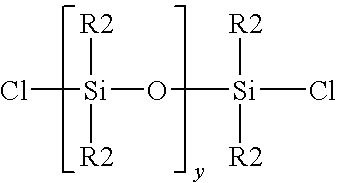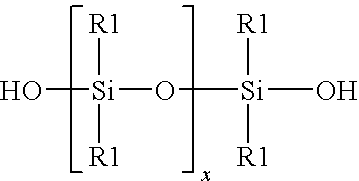Method for the redistribution of polyorganosiloxanes
a polyorganosiloxanes and polyorganosiloxanes technology, applied in the field of polyorganosiloxanes redistribution, can solve the problems of unfavorable enhancement capability, vacuum hydrolysis, and excess of linear materials or cyclic materials,
- Summary
- Abstract
- Description
- Claims
- Application Information
AI Technical Summary
Benefits of technology
Problems solved by technology
Method used
Image
Examples
example 1
[0021]A mixture was formed by mixing together 98 grain of a linear hydroxy endblocked polydimethylsiloxane and 140 gram of dimethyldichlorosilane Me2SiCl2. To a Teflon vessel was added 12.72 gram of 37 percent by weight aqueous hydrochloric acid, and 43.13 gram of the mixture of linear hydroxy endblocked polydimethylsiloxane and dimethyldichlorosilane. The vessel was sealed and pressurized to 100 psig with gaseous hydrogen chloride. The vessel was agitated by hand shaking for 5 minutes to achieve saturation concentrations of aqueous hydrochloric acid at these new conditions and facilitate contact between the two phases. The pressure was released and a sample of a chlorosilane / siloxane phase was removed and analyzed. GPC analysis showed that the siloxane chains were shortened. Analysis of the chlorosilane / siloxane mixture Before and After by GC is shown in Table 1.
[0022]
TABLE 1Redistribution of Me2SiCl2 / Siloxane MixtureSample Composition,Weight PercentBeforeAfterD30.140.08D40.434.14D...
example 2
[0023]A mixture was formed by mixing together 98 gram of a linear hydroxy endblocked polydimethylsiloxane and 140 gram of dimethyldichlorosilane Me2SiCl2. To a Teflon vessel was added 11.5 gram of 37 percent by weight aqueous hydrochloric acid and 58.18 gram of the mixture of linear hydroxy endblocked polydimethylsiloxane and dimethyldichlorosilane. The vessel was sealed and pressurized to 100 psig with gaseous hydrogen chloride. The vessel was agitated by hand shaking periodically for 30 minutes, to achieve saturation concentrations of aqueous hydrochloric acid at these new conditions and facilitate contact between the two phases. The pressure was released and a sample of a chlorosilane / siloxane phase was removed and analyzed. GPC analysis showed that the siloxane chains were shortened. Analysis of the chlorosilane / siloxane mixture Before and After by GC is shown in Table 2.
[0024]
TABLE 2Redistribution of Me2SiCl2 / Siloxane MixtureSample Composition,Weight PercentBeforeAfterD30.070.1...
example 3
[0025]A mixture was formed by mixing together 103.61 gram of a hydroxy endblocked linear polydimethylsiloxane and 120.02 gram of dimethyldichlorosilane Me2SiCl2. To a Teflon vessel was added 10.37 gram of 37 percent by weight aqueous hydrochloric acid and 50.96 gram of the mixture of linear hydroxy endblocked polydimethylsiloxane and dimethyldichlorosilane. The vessel was sealed and pressurized to 100 psig with gaseous hydrogen chloride. The vessel was agitated by hand shaking initially to achieve saturation concentrations of aqueous hydrochloric acid at these new conditions, and facilitate contact between the two phases. The vessel was then allowed to sit for three hours. The pressure was released and a sample of a chlorosilane / siloxane phase was removed and analyzed. GPC analysis showed that the siloxane chains were shortened. Analysis of the chlorosilane / siloxane mixture Before and After by GC is shown in Table 3.
[0026]
TABLE 3Redistribution of Me2SiCl2 / Siloxane MixtureSample Comp...
PUM
| Property | Measurement | Unit |
|---|---|---|
| temperature | aaaaa | aaaaa |
| temperature | aaaaa | aaaaa |
| weight | aaaaa | aaaaa |
Abstract
Description
Claims
Application Information
 Login to View More
Login to View More - R&D
- Intellectual Property
- Life Sciences
- Materials
- Tech Scout
- Unparalleled Data Quality
- Higher Quality Content
- 60% Fewer Hallucinations
Browse by: Latest US Patents, China's latest patents, Technical Efficacy Thesaurus, Application Domain, Technology Topic, Popular Technical Reports.
© 2025 PatSnap. All rights reserved.Legal|Privacy policy|Modern Slavery Act Transparency Statement|Sitemap|About US| Contact US: help@patsnap.com



